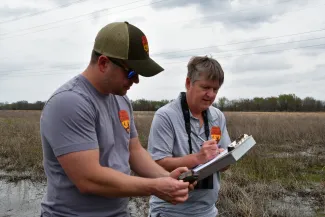To meet its constitutional expectations to manage and conserve the bird, fish, game and wildlife resources of the State, the Wildlife Department has gathered a large and diverse flock. Biologists maintain fish and wildlife populations and their habitats on the state’s Wildlife Management Areas and lakes; game wardens enforce hunting and fishing regulations; a communications team shares stories about those who enjoy the outdoors; and administrative staff manage conservation grant programs and sell licenses to hunters and anglers. Because the Wildlife Department is largely funded by the sale of these hunting and fishing licenses, much of its flock is dedicated to the conservation of game species. But a small wing of the agency, the Wildlife Diversity Program, concentrates its efforts on species that aren’t hunted or fished, with a special focus on species considered to be of greatest conservation need.

The Wildlife Diversity Program officially got its start in 1981 when the Oklahoma Legislature opened a revolving fund for the purpose of “preserving, protecting, perpetuating and enhancing nongame wildlife in this state.” But the program didn’t really take flight until 1983 when the first staff were hired.
In the four decades since, the program has added three additional staff members and considerably bolstered the larger Wildlife Department flock by joining forces with dozens of conservation partners. Through these partnerships, fish and wildlife populations have been documented and assessed; a developing base of knowledge has been shared with the public; and nongame conservation priorities have been identified in a statewide comprehensive strategy.
As the Wildlife Department looks to the future, it will continue to lean on this Comprehensive Wildlife Conservation Strategy, which serves as a guiding document for the Wildlife Diversity Program. The strategy not only identifies Oklahoma species that are rare, uncommon, or declining, but also identifies their key habitats and conservation issues, and proposes a variety of actions that could restore those species and their habitats.
By maintaining our strong partnerships with conservation-minded individuals, agencies, and organizations and fostering new connections, we believe we can fulfill this strategy and meet our combined goal of conserving Oklahoma’s wildlife heritage.
Wildlife Diversity Program Timeline
- 1981: The Nongame Wildlife Improvement Program Act is signed into law, creating what is now the Wildlife Diversity Program. The Act also opened a “Nongame Wildlife Improvement Fund” to support the program. Wildlife enthusiasts first contributed to the fund by donating a portion of their state tax refund, an opportunity which continues today.
- 1983: The first Nongame Program staff, two biologists and an information specialist, are hired.
- 1984: Nongame News, a seasonal newsletter offering program updates, is published for the first time. Stories about Oklahoma’s fish and wildlife and the people that work to conserve them are now shared in our monthly e-newsletter, the Wild Side. Subscribe at wildlifedepartment.com.
- 1995: The Oklahoma Tax Commission releases the first Wildlife Conservation License Plates, a new fundraising opportunity for the Wildlife Department. Today, wildlife enthusiasts can choose from nine plate designs.
- 1996: The Nongame Program gets a name change. The “Wildlife Diversity Program” was thought to describe the broad scope of the program more accurately.
- 2002: The Wildlife Department begins receiving State Wildlife Grant funding. Learn more about the conservation work funded by this program in “Pioneering Grant Program Reaches Milestone” on page 30.
- 2016: The state’s Comprehensive Wildlife Conservation Strategy is updated, identifying 313 species of greatest conservation need. This strategy directs our conservation efforts and priorities and is updated on a 10-year schedule.
- 2021: The 4th Edition of “A Field Guide to Oklahoma’s Reptiles and Amphibians” is published, showcasing our state’s 140 species of salamanders, frogs, alligator, turtles, lizards, and snakes. The custom-made guide is available at shop.gooutdoorsoklahoma.com.